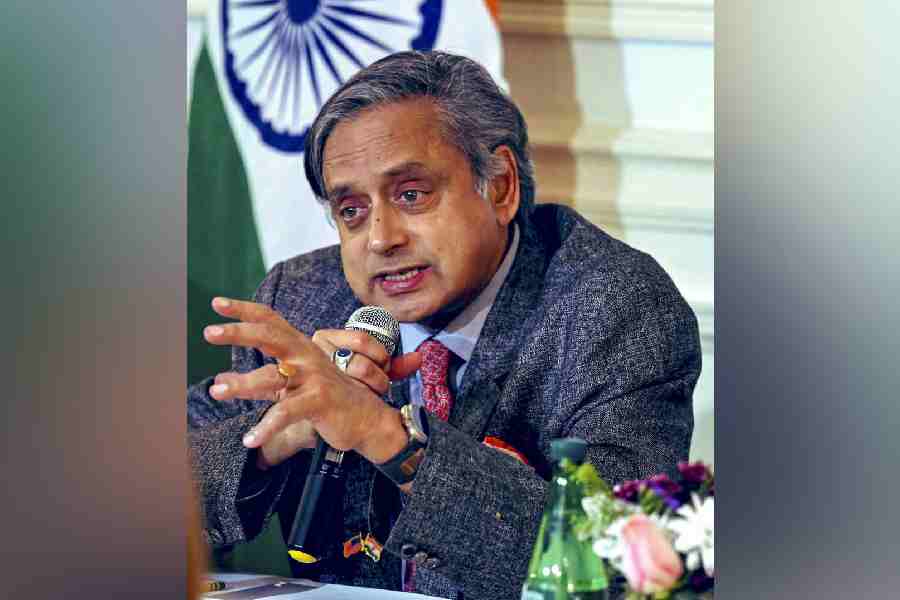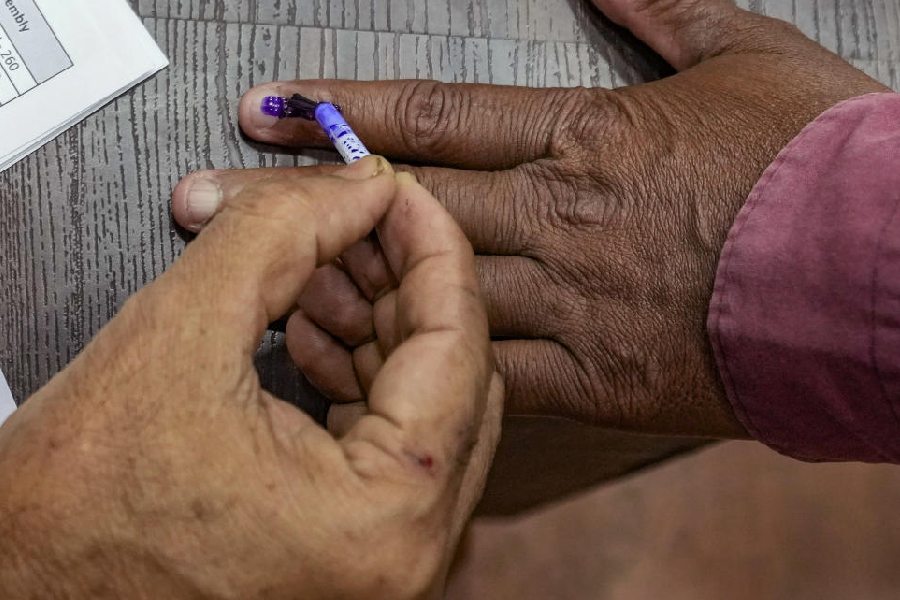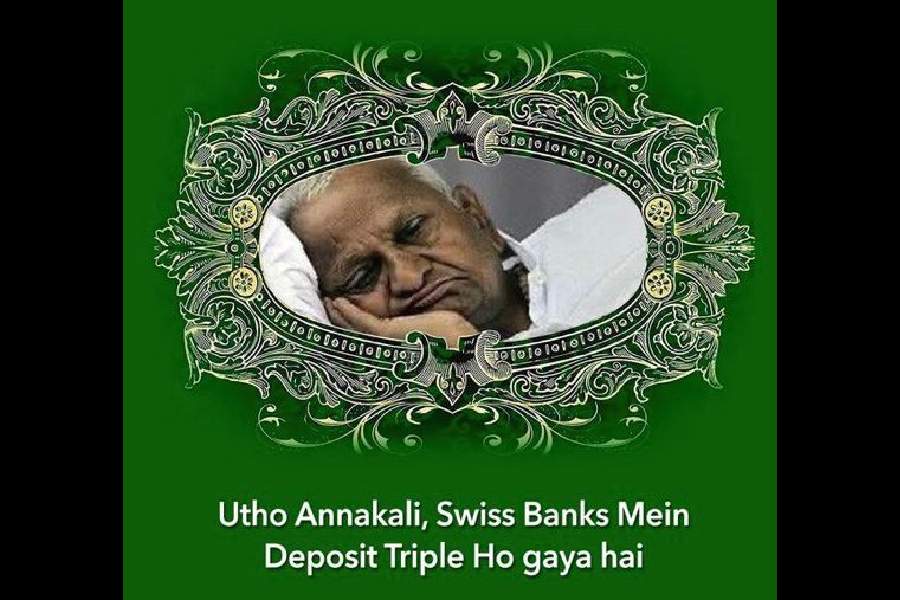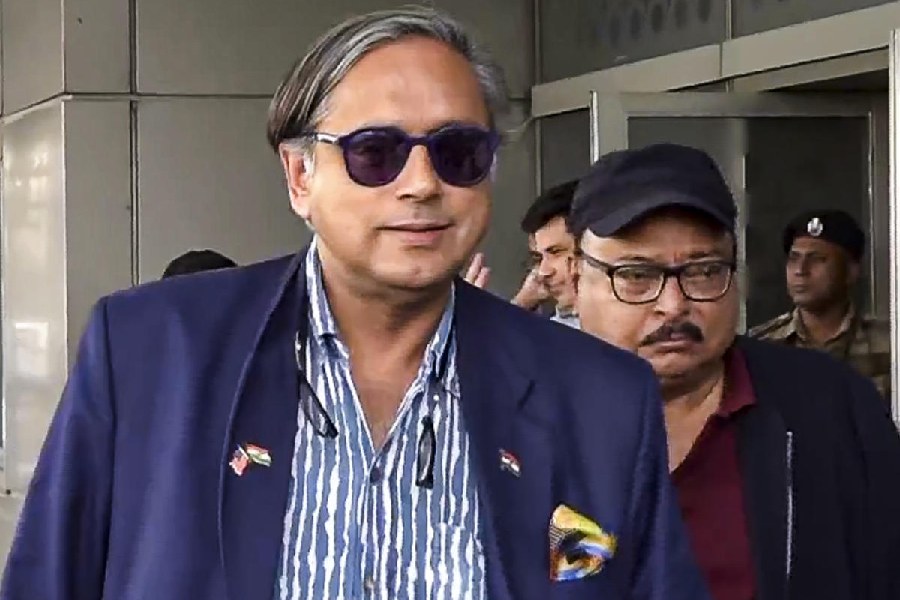 |
There is a painting in Paritosh Sen’s living room that catches your eye the moment you enter his apartment. Done by the artist himself, it is that of a large predatory bird looming over its hapless prey. Its eyes are cold and pitiless and a couple of limp snakes squirm between its steely beaks. It’s an awesome image of raw power — power that’s red in tooth and claw. The strong lines and bold brushstrokes are vintage Sen, who, at 87, is busier than he has ever been in his long and illustrious artistic life.
He walks out to greet me and leads me into the study-cum-studio of his flat in Calcutta’s upscale Alipore area. He is perhaps a little thinner than he was when I met him last some years ago. But he stands ramrod straight as usual — a tall, spare man dressed in a short-sleeved white kurta and pyjama, with his trademark white billowy sideburns still firmly in place. He doesn’t smile too often and his face seems to have set in the grimness of age.
Yet Sen really has a lot to cheer about. Counted among the greats of contemporary Indian art, he is today one of the most sought after artists in the country. His large canvases sell for anything between Rs 15 lakh and Rs 20 lakh and his smaller drawings can fetch between Rs 60,000 and Rs 80,000. “The demand is so great that I can barely cope with it,” he says.
But cope he does, and despite his advancing years, his creative juices flow undiminished. He paints every day —and not just to keep pace with the overwhelming demand for his works. Painting is a habit and a passion and he admits that he feels bored if he gives it a miss even for a day.
Success — in terms of serious money, that is — has come rather late to Sen. In fact, the upturn in the price of his paintings didn’t take place until after he had turned 80. “It’s not that I wasn’t well known before,” says Sen. But somehow, his paintings did not seem to excite buyers. Sen has an explanation for that: “I think people found it difficult to live with my paintings. Those who buy art to decorate their walls did not like my work.”
With commercial success eluding him, the young artist often had to go through untold privation and hardship. He remembers one such occasion when, in 1948, he went to Bombay to show his works. He ended up selling just one canvas and that too for a measly sum of Rs 100. He now had no money to go back to Indore where he used to teach art at Daly College. So for 15 days, until he got hold of the money to pay for his return fare, he survived on just bananas and water!
But whatever the setbacks, his artistic ebulliance rarely left him. “If I was depressed, it was transitory,” he says. “And no matter what happened, I never wanted to be anything other than an artist.”
The 1940s were, in fact, a breathtakingly stimulating time for the Indian artist — a time when modernism roared through contemporary Indian art and burst forth in refreshing new forms and idioms. Sen was in the thick of this great swirl of creative excitement. In 1943, he, along with fellow artists like Nirode Mazumdar, Pradosh Dasgupta, Gopal Ghosh and others, founded the Calcutta Group. They wanted to come up with a new language in art, something that would match the tumultuous reality of their times. This was when the nationalist movement was reaching a crescendo, the Japanese, with the help of the Azad Hind Fauj, were knocking on the doors of Manipur, and the British were engineering the famine in Bengal. “The lyrical style of Abanindranath Tagore was wholly unsuited to express this new reality,” says Sen. “So we were trying to find a new artistic language, one that was not afraid to draw from modern European movements in art such as impressionism, post-impressionism, cubism, dadaism, etc.”
Sen admits to having been particularly influenced by cubism, and especially by Picasso. “For a time I was under his spell, but it was a passing phase,” he says. He met the master in the early Fifties while he was studying art in Paris on a scholarship. The meeting that was to have been for 15 minutes, carried on for three hours, says Sen, who remembers Picasso as a man with “amazing humility”.
Sen loved his five-year sojourn in Paris. “Post-war Paris was poor, but it had a great soul,” he says. Did he have any French girlfriends? “Oh, I’ve had my share of sowing my wild oats,” he tells you with a ghost of a smile.
Sen’s journey into the world of art began when he was a schoolboy in Dhaka in the then East Bengal. Born into a huge family of 20 siblings — he was the 17th child — he was drawn to art even though no one in his family was similarly inclined. “Ours was the most prosaic family in the neighbourhood,” he says with some disgust. “There were no books in the house — just a Lakshmir panchali (a booklet containing chants to the Goddess Lakshmi), a panjika (almanac) and some notebooks of my father who was a kabiraj (doctor).”
By the time he was 13, his natural flair for drawing had made him decide that he wanted to be an artist. His family thought it a disastrous career choice but Sen was adamant. He left home at the age of 17 to study at the Government College of Arts in Madras. It was a liberating act that set him firmly on the path of his long creative journey.
On the way, Sen has put in teaching stints — he taught at the Institute of Printing Technology in Jadavpur University for 24 years, retiring in 1979 — and over the decades, his oeuvre has grown richer and more varied. He has written several books as well. His writing, especially his autobiographical sketches, is astonishingly visual, the word pictures almost as vivid as his paintings. In fact, when he read some of Sen’s pieces for the first time, good friend Satyajit Ray had told him, “Ebar tuli chhere kolom dhorun kichhu din. (Put aside your paint brush and take up the pen for sometime.)”
Today, a new generation of buyers, buoyed by the booming art market in the country, are snapping up his works. “Yes, I am selling well now,” he admits, “but the irony is that commercial success has come so very late in my life, when I no longer have the energy to work 13-14 hours a day.”
But then Sen is no stranger to irony. For much of his art is imbued with a startling sense of ironical wit. Whether it is the painting of a couple of merry sadhus taking a joyride on a motorbike, or that of a woman with headphones and her little dogs trotting around strapped with similar contraptions, many of his works carry a thinly-veiled satiric humour. So why is irony so pervasive in his art, I ask him.
“I find that it comes very naturally to me,” replies Sen. “And I am always aware that laughter and tears run in parallel streams.” But his wit is never more acerbic, his irony never more mordant than when he looks at himself. He gives the example of one of his self-portraits where he, an old man, is trying to hop onto a bus full of young women. Apparently it is a funny situation where the girls laugh at the antics of an old man. But the picture is really a lament on the loss of his own youth — its humour underpinned with poignancy.
Sen has had to make some concessions to his age now. He does not venture out too often any more. Once a connoisseur of good food and drink, he restricts himself to simpler fare these days. He and his wife of 50 years — the couple have no children — plan to buy a big screen plasma TV soon. That will possibly be the only visible sign of their considerable affluence. In fact, the Sens have not even bought a car yet. “We do not need a car,” the artist says simply.
And he refuses to get too excited about the boom in the Indian art mart. Though contemporary Indian art is beginning to sell for stratospheric prices at international auctions, Sen feels that it is yet to find proper recognition in the West. “Apart from the Tate Gallery in London, no major art museum in the West keeps modern Indian art,” he points out.
Right now, he has his hands full working on a forthcoming exhibition — Calcutta’s Galerie 88 will hold a show of 88 of his paintings when he turns 88 in September this year. Also on the cards is a new book that will contain a selection of his writings on art.
As he talks, shadows lengthen outside the window of his room. “I don’t think I have too many regrets,” he says. “An artist needs to have a lot of humanism. I feel I’ve been able to achieve that to an extent.”










